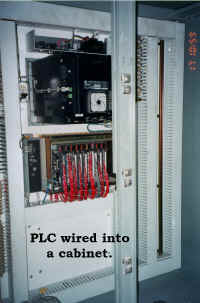May, 1999
Related Articles
Attention Structural
Engineers
Environmental
Site Assessment
 A subcommittee of APEGGA’s
Practice Standards Committee has been examining the question of whether modifications to
programmable logic controllers (PLCs) constitute engineering and, therefore, require an
engineer’s stamp. The subcommittee investigated current industry practices and
provided the following comments on general guidelines for PLC programming and
reprogramming. It concluded that engineers do, indeed, have an important role to play.
A subcommittee of APEGGA’s
Practice Standards Committee has been examining the question of whether modifications to
programmable logic controllers (PLCs) constitute engineering and, therefore, require an
engineer’s stamp. The subcommittee investigated current industry practices and
provided the following comments on general guidelines for PLC programming and
reprogramming. It concluded that engineers do, indeed, have an important role to play.
PLC use in industry is widespread. PLCs provide the logic that controls the sequencing of process plant or machine components. They also provide protective interlocks that govern the safe operation of interconnected or interrelated components, including startup and shutdown constraints. PLCs are used for applications ranging from operating single machines to controlling intricate batch processes in assembly plants and have largely, but not completely, replaced electro-mechanical and pneumatic devices. Although not dramatic in appearance—often just a small plastic box containing a programmable computer chip with a series of connectors for wires and LED (light emitting diode) indicators which flash as circuits are activated—PLCs, since their introduction on the market in the 1970s, have fundamentally changed how control circuits are designed and modified in the field.
The design process for engineering control systems is much simpler for systems incorporating PLCs than with those using traditional control devices. When designing logic circuits based on electro-mechanical or pneumatic devices such as relays and timers, a control engineer first devises a logic diagram which describes how one controlled action will affect another giving reference to sequencing and elapsed time. After the logic diagram is approved, an engineer or technician then draws a circuit diagram which shows how to hard wire these devices so as to replicate the logic outlined in the logic diagram. With hard-wired circuits, field modifications to the process can only be achieved by physically altering the components in the control cabinet and by reconnecting the wiring of the field devices. With PLCs, the design process has fewer steps. A logic diagram, frequently in the form of ladder logic, can be programmed directly into the PLC through a computer. The PLC is then wired individually to each control device and the system is ready for commissioning. Modifying the process logic can be performed with a few keystrokes on a laptop computer connected directly to the PLC even while it is running.
Since the PLC is used for so many applications, it is not surprising to find that the procedure for their reprogramming varies from one situation to another in industry. As an example, in some process plants, tradespeople routinely reprogram PLCs and are specifically trained to do so, but they do not consult an engineer prior to making the changes since the original control logic design has not been affected. Plant technicians also install PLCs to replace the original hard-wired circuitry of some control systems. If a new system is installed which requires a control system design, the PLC programming tasks are given to an engineer.
PLC programming changes for engineered systems need to be reviewed for their impact on the original design. One engineering consultant indicated that he would authorize a client to modify PLCs without his approval only if the PLC reprogramming does not affect a "primary" or stamped engineering document. Design parameters critical to the safe operation of a system are often indicated on Process and Instrumentation Drawings (P&IDs), System Logic Drawings, and Electrical Wiring Drawings for that system and are designated as primary drawings—these drawings always bear an engineer’s stamp. Secondary documents such as PLC ladder logic printouts may be issued without an engineer’s stamp; however, a validation step is always undertaken to ensure that the "output (i.e., secondary documents)" match the "input (primary documents)". It is recommended that when PLCs are reprogrammed such that the original logic is changed, the resulting logic printouts should either be validated and stamped or, preferably, that all PLC programming changes be recorded on the relevant primary documents as revisions.
The subcommittee concluded that users of PLCs should
establish standards for PLC reprogramming based on the potential consequences of the
modifications. Reprogramming practices need to be monitored on a case-by-case basis to
ensure that the impact of each change on the original design parameters and on the safety
and functionality of the system is based on good engineering practice for that type of
system. An engineer should stamp any PLC modifications which impact the original design
parameters or which could potentially affect the safety of personnel or equipment
involved. Engineers who are aware of any PLC modifications in their workplace should
ensure the soundness of the reprogramming practices used.